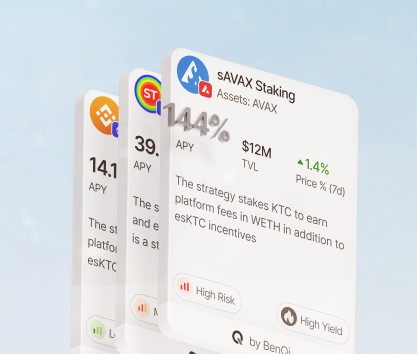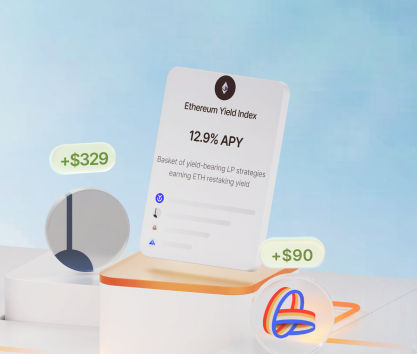With over 5,200 different tracked protocols to choose from, making informed investment decisions in the decentralized finance ecosystem can be difficult even if you have spare time, expertise, and experience. Close to 81% of all surveyed institutional investors believe that the DeFi sector will have an impact on the way financial organizations do business. Many are seeing that DeFi APYs consistently beat what tradfi can offer.
Some crypto earning strategies can be employed even on a low budget. However, you must focus on building a balanced portfolio and consider various risks specific to this particular ecosystem. For example, tradfi investors almost never encounter impermanent loss or technological vulnerabilities associated with using autonomous smart contracts.
We will give you several exciting strategies to explore in 2025 and earn money consistently while beating the US treasury bond yield benchmark (roughly, 4%).
Effective blockchain passive investments
Various financial instruments available to DeFi investors allow them to engage in a diverse range of strategies that can produce impressive outcomes. It is important to search for options that allow you to take a back seat and focus on general control and tracking instead of micromanaging every single operation and position. Active trading can be a good way to make money but it works for people who are ready to dedicate all their time and efforts to trading all the time.
Modern investors have access to all sorts of investment opportunities in the DeFi sector. For instance, Rivo is offering preselected strategies chosen by industry experts. These are mostly automated investment tools that require you to make a decision only once and simply collect returns.
The Base Yield Index is a good target for investors interested in spreading capital and focusing on novel instruments with a strong potential for growth. It produces roughly 18.8% weekly APY.
Many other passive income instruments that you can use in DeFi have relatively high risk and pay a corresponding premium making them lucrative options for capital holders interested in short-term returns and flexibility.
Some risk mitigation strategies, such as diversifying capital allocation and focusing on investment instruments and digital assets that have different levels of risk and volatility, can be employed to varying degrees of success. However, a DeFi investor should not base decision-making on optimistic prognoses and dismiss potential risks.
Due to the necessity to regularly adjust positions and move funds around, you can’t call most DeFi strategies passive. Nonetheless, some do offer some hands-off experience.
Direct staking and liquid staking
If you are looking for a good place to park your capital for a relatively long period, staking directly on mainnets is a sound plan. Several tokens can be staked directly and generate respectable returns with an impressive level of consistency and reliability:
- Ethereum is the king of staking. It is the biggest PoS chain by a long shot and offers dynamic APY on ETH stakes ranging from 1% to 18.1% depending on the total volume of staked tokens and other factors.
- MATIC is the native token of the Polygon network. You can stake tokens and receive up to 11.5% APY depending on where you stake. Average returns hover above 4.55% with the CRP (current reward percentage) fixed at 4.95%.
- Staking SOl yields roughly 7.1% in January 2025. It is a solid asset considering the strong performance of the asset throughout the last year as it managed to gain 164% and achieve the year’s high of $257 in December.
You can also utilize liquid token staking techniques by working with protocols like Lido, which offers 2.8% APY and gives stETH at a 1:0.95 ratio, or Jito with its 15% SOL APY and a 1:0.85 ratio of SOL to JitoSOL. Investors restake their liquid tokens to boost profitability even further or use something like fx Protocol to create a leveraged USD position.
Liquid staking protocols are often used in yield optimization methods that focus on increasing the utilization of underlying assets like mainnet tokens. It can be a solid plan for many investors who are not afraid of taking on higher risks to gain better ROI. Note that using fx Protocol and similar platforms is like exposing your portfolio to additional risk due to leverage and double utilization of ETH.
Safe DeFi passive income strategies
Lending in DeFi is quite safe for investors who want to become fund providers as all loans must be fully collateralized or settled before the finalization of a transaction (i.e. flash loans). It means that all loans will be repaid no matter what. The issue here is that they can be repaid in an asset that you don’t need or would like to avoid.
Lending is one of the biggest DeFi investment categories represented by 476 protocols across over 90 chains with a combined TVL of over $49.8 billion as of the time of writing.
Here are some investment opportunities you may find appealing:
- Aave is a good destination for users interested in allocating stablecoins to receive reliable returns that are higher than anything you can find in tradfi. For instance, USDT and USDC pools yield 6.24% and 6.54% respectively with 30-day mean averages exceeding expectations reaching 7.33% and 8.2%. Most high-yield bank accounts do not give you more than 5%.
- Compound can be a solid destination for many users who want to receive rewards while lending out mainstream coins. Allocating ETH here yields 1.78% base APY and 0.5% in COMP rewards allowing investors to sit on their holdings safely and keep them for long periods without risking anything and receiving a low premium.
Increasing decentralized finance income
Some of the best options are in the yield farming sector with over 530 different protocols and a solid chunk of 1500 DEXes offering very high premiums and sizeable rewards. If you want to utilize your capital effectively and receive solid returns, it is a good idea to use protocols like Pendle, Pancakeswap, Curve DAO, Convex Finance, and many others.
Here are some solid yield generation methods you can use:
- Pools with fixed maturation from Pendle pay nicely. For instance, you can invest in the SUSDE pools maturing in March 2025 for 18.59% base APY and up to 1.14% in PENDLE rewards. Returns may depend on how funds are utilized. For example, the base APY is slightly higher if SUSDE is used for the PT-sUSDE pool.
- Convex Finance is strongly focused on producing liquidity for Curve DEX. Depending on the digital asset, you can earn a solid return with 225 pools averaging a 14.43% APY as of the time of writing. For example, investing in the CVXCRV pool yields 15.21% in rewards. Allocating capital to the ETH-stETH pool yields 2.09% with varying types of rewards in CVX/CRV or CVXCRV.
It is important to learn various liquidity pool mechanisms to make informed decisions. For example, the aforementioned Pendle PT-sUSDE pools can be quite confusing and many investors try to avoid it. However, it is just a way of shifting around yields and value.
The main takeaway
DeFi investors have access to a myriad of investment mechanisms that can be used without actively participating in the market. Work with platforms like Rivo if you want to enjoy a hassle-free investment experience in the DeFi ecosystem.









